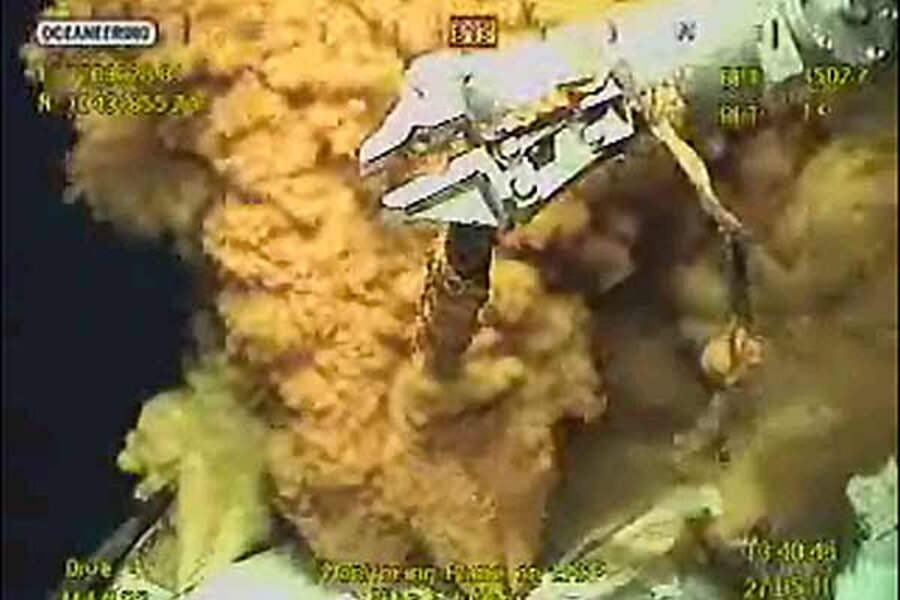The BP 'top kill' live feed: The armchair explorer's guide
Loading...
| Atlanta
A robot sub holding a wrench with a metal fist. A dark plume bursting forth from a pipe. A liquid, soundless undersea universe, as mesmerizing as it is terrifying.
To be sure, the BP live video feed of the "top kill" maneuver has forged a peculiar connection for many viewers to the undersea disaster. Reacting to drama on Sunday, before the "top kill" attempt began, the blogger Monkeyfister noted: "While watching, ANOTHER major 'explosion' occurred. ROV Cam now covered in oil. Our Favorite Disaster Bot is taking a beating."
Clearly, figuring out exactly what is going on in the BP live video feed of the "top kill" attempt requires a bit of background – and imagination.
First of all, what is a "top kill"? It consists of pumping heavy mud at over 6,000 pounds per square inch of pressure into the well head, to stem the oil geyser that has fouled the Gulf of Mexico with as much as 19,000 barrels of oil per day since the Deepwater Horizon rig blew up on April 20 and sank two days later.If successful, it will be chased by a load of concrete to cap the well.
In the feed, subs with nicknames like Explorer 1 and Explorer 2 are occasionally seen working on a large metal structure. That is the infamous blowout preventer (BOP) that attached the rig to the wellhead, and which failed to stem the kick of gas that escaped on April 20, causing the explosion and subsequent leak.
The view of the four plumes coming out of a turtle-shell-shaped metal contraption is the top of the BOP. Those plumes used to be oil, but are now apparently primarily mud being pumped from the surface. There is also an occasional shot of one of the leaks in the Deepwater Horizon's "riser" pipe that is now lying on the sandy bottom.
Amateur geologists have been live-blogging changes in the feed and the plume. So far, what they've seen seems to confirm word from Coast Guard Commandant Thad Allen that the oil geyser has been tamed, if not yet killed.
Over at the Oil Drum blog, writer "Heading Out" put up two feed images, one taken Wednesday afternoon and one taken Thursday morning. Overnight, the plume changed color and velocity, indicating a change in the mixture of mud and oil and the speed of the leak.
"Notice how the flow was longer and straighter in the first image, indicating that it was at higher pressure … and that now it blows out at much closer distance, meaning it doesn't have the same pressure," he writes.
Commenter Rockman couldn't make the same determination: "I won't try to guess what the videos are indicating. No idea if their pressure sensors can tell much about the kill process. But I would think there will be an obvious answer when they stop pumping mud: if they've put enough head on the bottom hole to stop the flow then we should little or no return coming out of the leaks," he writes.
But despite the cautious good news, armchair explorers could yet see more drama on the eerily clear underwater set: The tricky part, once the pressures have been resolved, is when BP eases the mud pressure in order to cement the wellhead. Don't hold your breath, though. That could be three to four days from now.
"They are waiting to make sure the mud has reached pressure equilibrium with the oil gusher. Further they want to make sure that the situation is stable before sending down cement which has to harden and completely seal the well head," writes SFGate.com commenter Yobie Benjamin, who has kept a steady eye on the deep-sea drama. "Now imagine a cork on top of a well head and that we are hoping against hope that the cork will hold. If the oil pressure is so great, it can push the cork out and result in a more catastrophic situation."
Related:





